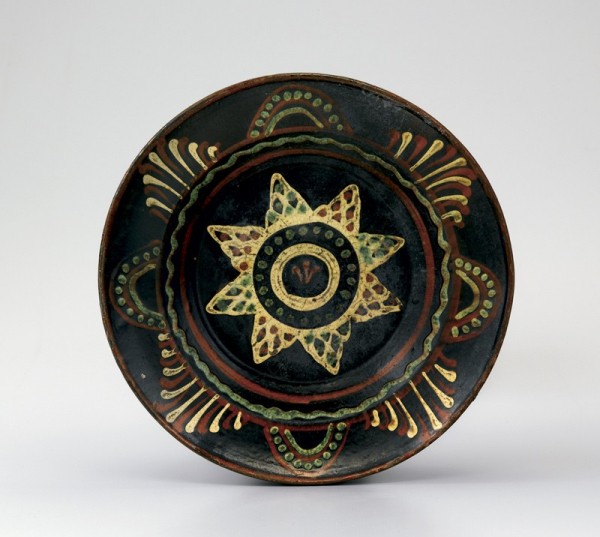
Dish, Alamance County, North Carolina, 1790–1820. Lead-glazed earthenware. D. 10". (Courtesy, Old Salem Museums & Gardens; unless otherwise noted, photos by Gavin Ashworth.)

Bottle, Alamance County, North Carolina, 1790–1820. Lead-glazed earthenware. H. 6". (Private collection.)

Dish and bowl fragments recovered at Solomon Loy’s pottery site, Alamance County, North Carolina, 1825–1840. Lead-glazed earthenware and bisque-fired earthenware. (Courtesy, Research Labs of Archaeology, UNC-Chapel Hill.) All of these Solomon Loy fragments are from site 31AM191.

Flask, Alamance County, North Carolina, 1770–1790. Lead-glazed earthenware. H. 5 3/8". (Courtesy, Old Salem Museums & Gardens.)
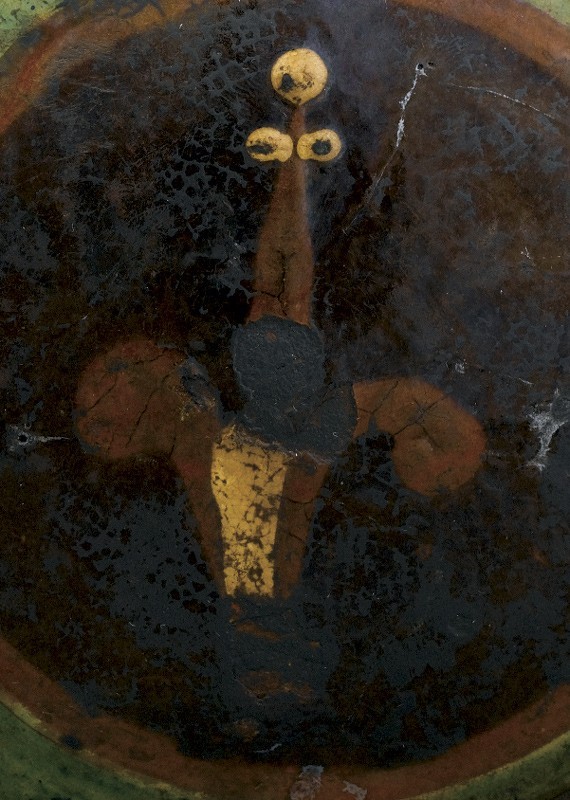
Detail of the decoration on one side of the flask illustrated in fig. 4.

Detail of Hyacinthe Rigaud, Cardinal de Bouillon, Perpignan, France, 1708. Oil on canvas, 97" x 95". (Courtesy, Musée Hyacinthe Rigaud.)

Antoine Raspal, Portrait de Jeune Fille en Costume d’Arles, France, 1779. Oil on canvas. 24 1/2" x 24". (Courtesy, Musée Granet, Aix-en-Provence, don du docteur Arnaud.)

Dish, Alamance County, North Carolina, 1770–1790. Lead-glazed earthenware. D. 12 1/2". (Courtesy, Old Salem Museums & Gardens.)
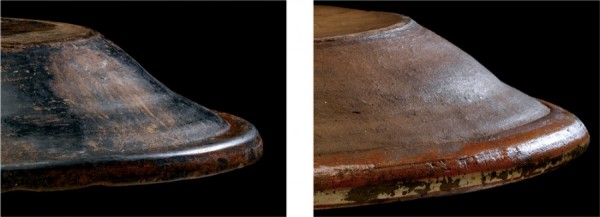
Details showing the back profiles of the dish illustrated in fig. 8 (left) and a dish attributed to the Moravian pottery in Salem, North Carolina (right).

Detail of the cavetto decoration on the dish illustrated in fig. 8.

Detail of the decoration on the shoulder of the flask illustrated in fig. 4.

Powder flask, probably Germany, 1600–1650. Wood, brass, and wire inlay. (Private collection.)
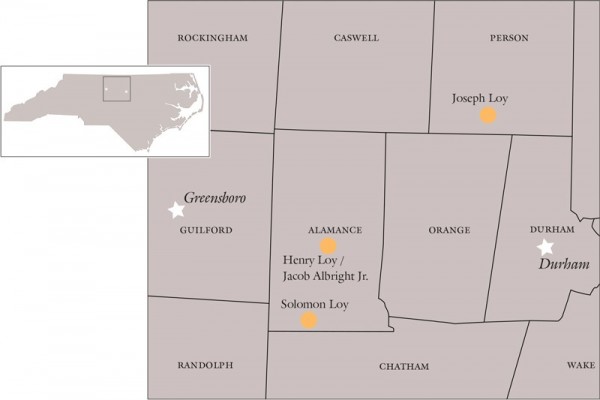
Map showing pottery site locations for Henry Loy, Jacob Albright Jr., Solomon Loy, and Joseph Loy.

Dish fragments recovered at Jacob Albright Jr.’s pottery site, Alamance County, North Carolina, 1795–1820. Lead-glazed earthenware. (Courtesy, Research Labs of Archaeology, UNC-Chapel Hill.) The fragment at the upper right has marbleized decoration. Slip-decorated earthenware might have been produced at this site before it was occupied by Albright and his son-in-law Henry Loy.

Details showing a cavetto fragment (lead-glazed earthenware) recovered at Jacob Albright Jr.’s pottery site and the marly decoration on the dish illustrated in fig. 30.

Dish fragments recovered at Jacob Albright Jr.’s pottery site, Alamance County, North Carolina, 1795–1820. Bisque-fired earthenware. (Courtesy, Research Labs of Archaeology, UNC-Chapel Hill.)

Mug fragments recovered at Jacob Albright Jr.’s pottery site, Alamance County, North Carolina, 1795–1820. Lead-glazed earthenware. (Courtesy, Research Labs of Archaeology, UNC-Chapel Hill.)
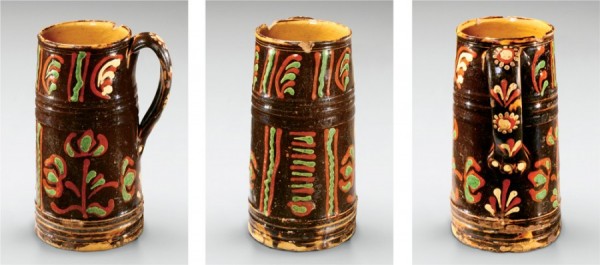
Side, front, and rear views of a tankard, Alamance County, North Carolina, 1785–1810. Lead-glazed earthenware. H. 9". (From the Collections of The Henry Ford 59.144.3)

Handle fragment recovered at Joseph Loy’s pottery site, Person County, North Carolina, ca. 1833. Lead-glazed earthenware. (Courtesy, Research Labs of Archaeology, UNC-Chapel Hill.)

Dish, Alamance County, North Carolina, 1775–1795. Lead-glazed earthenware. D. 15 1/2". (Courtesy, Old Salem Museums & Gardens.)

Dish, Alamance County, North Carolina, 1775–1795. Lead-glazed earthenware. D. 12 5/8". (Courtesy, The Barnes Foundation.)

Dish, Alamance County, North Carolina, 1775–1795. Lead-glazed earthenware. D. 14 7/8". (From the Collections of The Henry Ford 59.143.1)
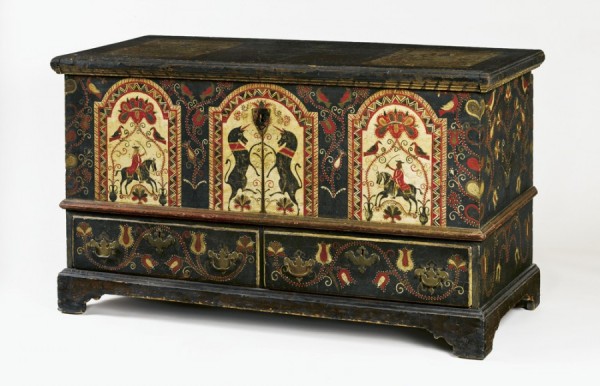
Chest, attributed to Bern Township, Berks County, Pennsylvania, 1785–1795. Tulip poplar and pine. H. 28 5/8", W. 52 1/2". (Courtesy, The Metropolitan Museum of Art.)

Detail of the painted decoration on one side of the chest illustrated in fig. 23.

Details showing the decoration in the cavetti of the dishes illustrated in fig. 20 (left) and fig. 21 (right).

Details showing the back profiles of the dishes illustrated in fig. 20 (top) and fig. 21 (bottom).

Dish, Alamance County, North Carolina, 1785–1810. Lead-glazed earthenware. D. 12 1/2". (From the Collections of The Henry Ford 59.145.2)

Detail showing the decoration in the cavetto of the dish illustrated in fig. 27 (left) and a cavetto fragment (right) recovered at Jacob Albright Jr.’s pottery site.

Dish, Alamance County, North Carolina, 1790–1820. Lead-glazed earthenware. D. 10 7/8". (Courtesy, Old Salem Museums & Gardens.)

Dish, Alamance County, North Carolina, 1790–1820. Lead-glazed earthenware. D. 10 3/8". (Courtesy, Old Salem Museums & Gardens.)

Dish, Alamance County, North Carolina, 1790–1820. Lead-glazed earthenware. D. 11". (Courtesy, Colonial Williamsburg Foundation; photo, Hans Lorenz.)

Details showing the back profiles of the dishes illustrated in (from left to right) figs. 1, 29, and 30.
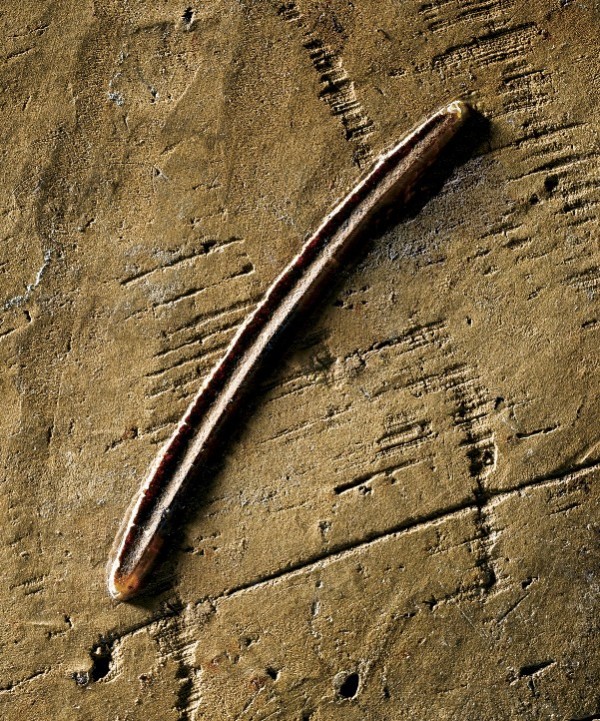
Detail of the fluted separator on the back of the dish illustrated in fig. 29.

Detail of the post-production marks on the back of the dish illustrated in fig. 1.

Dish, Alamance County, North Carolina, 1790–1820. Lead-glazed earthenware. D. 10". (Private collection.)

Detail of the post-production marks on the back of the dish illustrated in fig. 35.

Dish, Alamance County, North Carolina, 1790–1820. Lead-glazed earthenware. D. 10". (Private collection.) This dish has a twentieth-century recovery history in Alamance County.

Detail of the back profile of the dish illustrated in fig. 37. The profile of this example is virtually identical to that of the dish illustrated in fig. 35.

Dish fragment recovered from lot 49 in Salem, North Carolina, 1780–1820. Bisque-fired earthenware. (Courtesy, Old Salem Museums & Gardens.)

Punch bowl, Alamance County, North Carolina, 1790–1810. Lead-glazed earthenware. H. 5 3/4". (Private collection.)
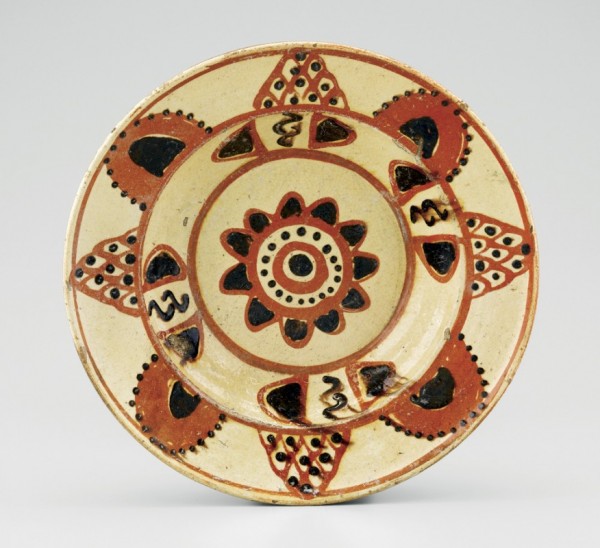
Dish, Alamance County, North Carolina, 1800–1835. Lead-glazed earthenware. D. 11 1/2". (Courtesy, Old Salem Museums & Gardens.)
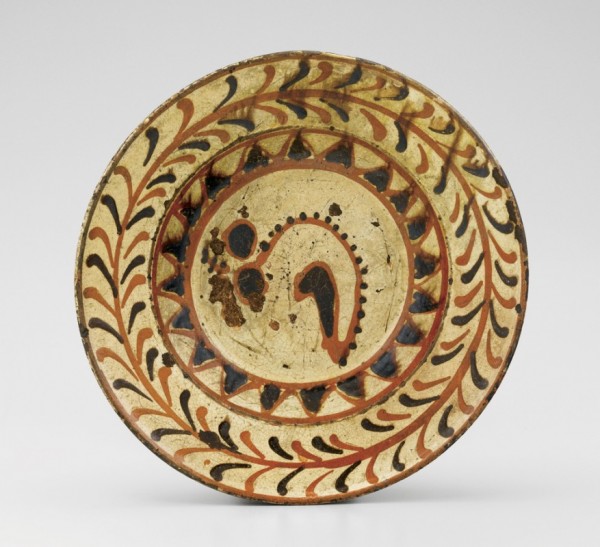
Dish, Alamance County, North Carolina, 1800–1835. Lead-glazed earthenware. D. 11". (Courtesy, Old Salem Museums & Gardens.) This is the earliest dish with “nested triangles,” a motif commonly employed by Solomon Loy. Antecedents for this motif can be seen on the front panels of paint-decorated chests attributed to Bern Township in Berks County, Pennsylvania (see fig. 23).

Details showing the back profiles of the dishes illustrated in fig. 41 (left) and fig. 42 (right).

Details showing the decoration in the cavetti of the dishes illustrated in fig. 1 (left) and fig. 41 (right).

Details showing the decoration in the cavetti of the dishes illustrated in fig. 20 (left) and fig. 42 (right).

Pitcher, Alamance County, North Carolina, 1785–1810. Lead-glazed earthenware. H. 10". (Courtesy, Old Salem Museums & Gardens.)

Fragmentary pitcher, Alamance County, North Carolina, 1790–1820. Lead-glazed earthenware. (Courtesy, Research Labs of Archaeology, UNC-Chapel Hill.)

Pitcher, Alamance County, North Carolina, 1800–1835. Lead-glazed earthenware. H. 10". (Private collection.)

Details showing the rims and handles of the pitchers illustrated in fig. 46 (left) and fig. 48 (right).

Dish, Alamance County, North Carolina, 1800–1835. Lead-glazed earthenware. D. 10 7/8". (Private collection.)

Dish, attributed to Solomon Loy, Alamance County, North Carolina, 1825–1840. Lead-glazed earthenware. D. 12". (Private collection.)

Pitcher, Alamance County, North Carolina, 1790–1820. Lead-glazed earthenware. H. 10". (Courtesy, High Museum of Art.)

Pitcher, Alamance County, North Carolina, 1790–1820. Lead-glazed earthenware. H. 10". (Private collection.)

Detail of the rim of the pitcher illustrated in fig. 53.

Detail of the handle terminal and foot of the pitcher illustrated in fig. 53.

Rear and side views of a pitcher, Alamance County, North Carolina, 1790–1820. Lead-glazed earthenware. H. 10 1/2". (From the Collections of The Henry Ford 59.15.3)

Pitcher, Alamance County, North Carolina, 1790–1820. Lead-glazed earthenware. H. 6 1/2". (Courtesy, Old Salem Museums & Gardens.)

Detail of the handle and body of the pitcher illustrated in fig. 57.

Fragmentary pitcher, Alamance County, North Carolina, 1800–1835. Lead-glazed earthenware. (Courtesy, Old Salem Museums & Gardens.) The stylized plant motif on this object is visible in fig. 60 (right).

Detail showing the decoration on the pitchers illustrated in fig. 46 (left) and fig. 59 (right).

Dish, Alamance County, North Carolina, 1800–1835. Lead-glazed earthenware. D. 10". (Private collection.)

Sugar pots, Alamance County, North Carolina, 1790–1820. Lead-glazed earthenware. H. 12 3/4" (left), 13" (center), 7" (right). (Courtesy, The Metropolitan Museum of Art [left], From the Collections of The Henry Ford 59.143.3[center], private collection [right].) The pot with the white ground descended in the Crouse family of Alamance County.

Sugar pot, Alamance County, North Carolina, 1800–1820. Lead-glazed earthenware. H. 8". (Private collection.) This jar descended in the Löffler (Spoon) family of Alamance County and southeastern Guilford County. The 1787 tax list for the St. Asaph’s district lists “Widow Sarah Spoon.” John, Adam, and Peter Spoon were listed in the 1792 assessment.

Sugar pots, Alamance County, North Carolina, 1800–1830. Lead-glazed earthenware. H. 8" (left), 8" (right). (Courtesy, Old Salem Museums & Gardens.)

Sugar pots, Alamance County, North Carolina, 1800–1830. Lead-glazed earthenware. H. 10" (left), 10" (right). (Private collection.)

Condiment pot, Alamance County, North Carolina, 1795–1820. Lead-glazed earthenware. H. 5". (Courtesy, Old Salem Museums & Gardens.) The lower section of this pot has a partition in the center.

Bowl, Alamance County, North Carolina, 1790–1820. Lead-glazed earthenware. H. 3". (Private collection.)

Sugar pot, Alamance County, North Carolina, 1770–1790. Lead-glazed earthenware. H. 8 1/4". (Courtesy, Old Salem Museums & Gardens.)
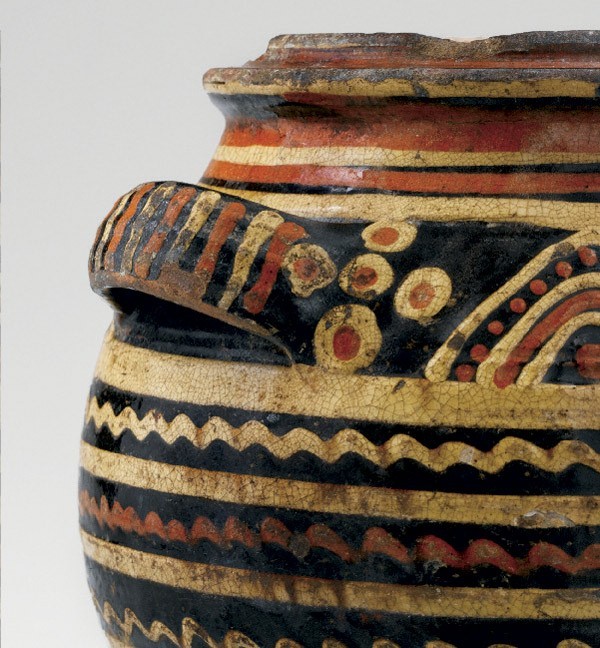
Detail of the rim and handle of the sugar pot illustrated in fig. 68.

Exterior and interior views of a sugar pot lid, Alamance County, North Carolina, 1770–1790. Lead-glazed earthenware. D. 7". (Courtesy, Old Salem Museums & Gardens.)

Sugar pot, Alamance County, North Carolina, 1785–1810. Lead-glazed earthenware. H. 7 1/2". (Courtesy, Old Salem Museums & Gardens.)
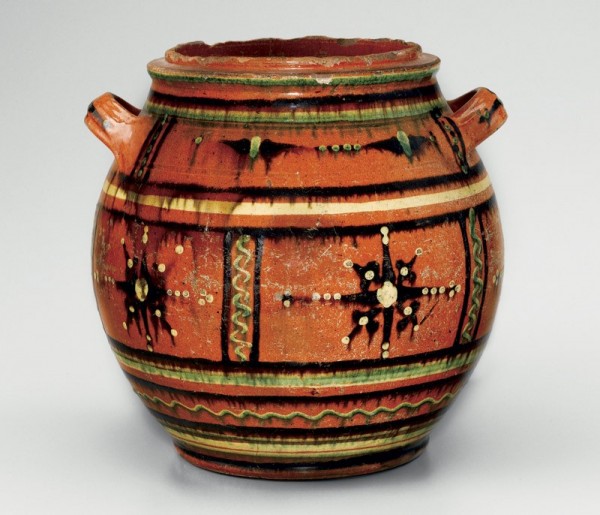
Sugar pot, Alamance County, North Carolina, 1790–1820. Lead-glazed earthenware. H. 10 1/2". (Private collection.)

Details showing the cross and fleur-de-lis decoration on the sugar pot illustrated in fig. 72 (left) and the dish illustrated in fig. 31 (right).

Sugar pot, Alamance County, North Carolina, 1790–1810. Lead-glazed earthenware. H. 10". (Courtesy, Old Salem Museums & Gardens.)

Sugar pot, Alamance County, North Carolina, 1790–1810. Lead-glazed earthenware. H. 6 1/4". (Courtesy, Colonial Williamsburg Foundation.)
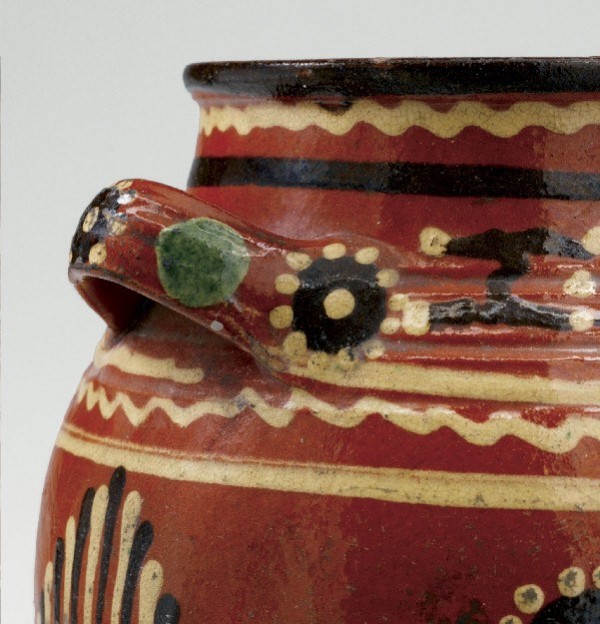
Detail of the rim, handle, and body of the sugar pot illustrated in fig. 74.

Detail of the rim, handle, and body of the sugar pot illustrated in fig. 75.

Sugar pot, Alamance County, North Carolina, 1795–1820. Lead-glazed earthenware. H. 10". (Courtesy, Old Salem Museums & Gardens.) The color and surface texture of the lid are somewhat different from those of the body. Although it is possible that this discrepancy denotes an early “marriage,” the fit of the lid suggests that it is original. Placement in the kiln and subsequent use could account for the differences visible here.

Detail of the rim, handle, and body of the sugar pot illustrated in fig. 78.

Confirmation certificate for Johannes Löffler Jr., Guilford County, North Carolina, 1779. Ink and watercolor on paper, 8 1/2" x 12 7/8". (Courtesy, Old Salem Museums & Gardens; photo, Wesley Stewart

Dish, Alamance County, North Carolina, 1800–1835. Lead-glazed earthenware. D. 12 1/2". (Courtesy, The Barnes Foundation.) This dish is probably an early example by Solomon Loy or one of his immediate predecessors.

Details showing the marly decoration on the dishes illustrated in fig. 1 (left) and fig. 81 (right).

Details showing the decoration on (from top to bottom) the flask and dishes illustrated in figs. 4, 31, 81, and 51.
